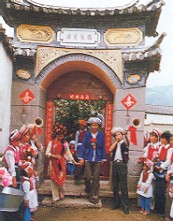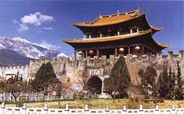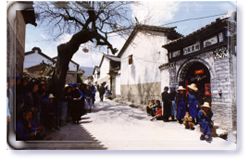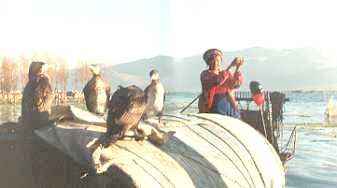
1. What does the word "Dali" mean?

|
|
1. What does the word "Dali" mean? |
|
1. What does the word "Dali" mean?
The names of places often have very interesting stories. Why is the Erhai Lake region called Dali? Here there is an interesting story. A minister of Nanzhao Kingdom called Yang Ganzen staged a coup and overthrew the Nanzhao Kingdom in AC 902. He founded a new state called "Dali Gu" and became its ruler. He was a cruel, ferocious and greedy person. Then followed a lot of corrupt officials. They extorted excessive taxes and levies. They rode roughshod and made the country a big mess and so, the people had no means of livelihood. According to the record of the history, the country was then "up side down".
| At this time, there was an honest and upright official called Duan Siping could not bear the situation and decided to revolt. He wanted to overthrow the Yang's regime and "clean the country up". Luckily with the support of the people he succeeded. Later, in AC 938 he founded a new state called Dali. Here, in Chinese "Da" means "big or complete", "li" means "to clean up". Therefore the "Dali" means to give it a big and complete clean up. |  |
 |
Dali is located in the western part of Yunnan Province, specifically at longitude 99 58' to 100 27'E and at latitude 25 25' to 25 58'N. With Erhai Lake on the east and Cangshan Mountains on the west, the area measures 46.3 kilometers from east to west and 59.3 kilometers from north to south, covering 1468 square kilometers, of which Erhai Lake accounts for 15 percent. The main peak of the Cangshan Mountains rises 4122 meters above sea level and the basin formed by a land depression is 1975.5 meters above sea level. |
|
Dali's climate belongs to the low-latitude, high-elevation north subtropical monsoon type. The area enjoys adequate sunshine with an annual average of 2473.8 hours. Annual precipitation in the area is 1100 mm, with annual mean temperature of 15.1, an average temperature of 8.7 in January and average temperature in July of 21. |
The annual frost-free period lasts 239 days. Dali doesn't have four seasons but only dry and wet periods during the year. Dali's climate is neither too cold nor too hot, but mild all year round.
 |
More than 3000 years ago there have been people living around the Erhai Lake. In the beginning of the 2nd century, Emperor Wudi of the Western Han Dynasty established the Yeyu County in this area. AC 738, Piluoge, a Bai people established a powerful kingdom, the Nanzhao, south of Dali initially allying its power with the Chinese against the Tibetans. |
The Nanzhao Kingdom fell in AC 902 and was replaced by Dali Kingdom in AC 938 by another Bai man called Duan Siping. Dali Kingdom was later overrun by the Mongols in AC 1253. During the two kingdoms Dali had been the political, economic, cultural and military center of Yunnan for more than 500 years. After the year AC 1274, the Mongols established Yunnan province under which they set up the Taihe County in Dali. The name "Taihe County" was changed to "Dali County" in 1913. And Dali County was combined with Xiaguan, the new city, as Dali City. Because of its long and important history, it was appointed as one of the 24 most historical and cultural cities in China.
5. Administrative districts, governmental organizations
The Dali Bai Nationality Autonomous Prefecture is one of the 17 prefectures of Yunnan province. It has 11 counties and one city. The population is more than 2,700,000. There are 12 nationalities including Han, Bai, Yi, Hui, Lisu, Miao, Naxi, Tibetan etc. The population of The Bai is 860,000, the Yi 310,000, the Hui 50,000 and the Lisu 20,000. Dali City is the capital of the Prefecture, it has two towns (Dali town and Fengyi town) under its control. The population of the city is 430,000, 43% of which is Bai Nationality. Most people speak Chinese with a local accent. The villagers speak Bai language, which has no written form.
| Dali is abundant in natural resources, it has the famous Dali marble mine. The Erhai Lake is one of the seventh biggest freshwater lakes in China. |
 |
It is 1973 meters above the sea level, covering 250 square kilometers. Dali also boasts many other advantages like geographical location, geological structures, local products and natural resource in addition to the local customs, lifestyle, natural wilderness and lovely scenery. For all these reasons, tourists and explorers from both at home and abroad have come to visit Dali. |
 |
There are 17 cinemas, 2 cultural centers, 2 libraries (which have more than 400000 copies of all kinds of books), 2 museums (which have collected more than 2700 pieces of valuable articles), a gymnasium (the building area is 17400 square meters, have 3300 seats indoors and 17000 seats outdoors), 1 broadcasting station and 3 TV stations in Dali City. |
There are 189 schools in the city, among them there is one medical college (Dali Medical College), one teacher's college, one TV university, 5 secondary specialized schools, 5 secondary vocational schools, 3 training schools for adults, 36 ordinary middle schools and 137 primary schools. The Medical College accepts students from all over the province, and a few students from 6 other provinces. The Teacher's College and The Agriculture school accept a few students from some of other prefectures. The other schools only accept students from the Dali Prefecture.
The children are sent into the kindergartens at the age of 4. The parents have to pay the kindergarten 150-250 yuan each month. The children stay in the kindergarten from 7:30 a.m. to 5:50 p.m. They will be sent into the primary schools at the age of 7. There is no kindergarten in the countryside, so the children of the villagers' have to go the primary school at the age of 6 to get a pre-education in the first year. The children have to study in primary school for 6 years then they go to study in the middle schools (junior) for another 3 years.
| When they finish junior school, they have to take a test to see which higher school they can go. Usually there are 3 choices: to go to the high school (senior middle); to the secondary specialized school; or just go back home and wait for chances to find a job if they don't get a higher mark in the test. Those who go to the secondary specialized schools will study 3-4 years. |  |
Those who go to study in the senior middle school will have to study another 3 years and take a very difficult nation wide examination to enter the universities or colleges. They have their 3 choices: 1). To enter the universities if their marks are very high. They usually study for 4 years. 2). If their marks are not high enough, they can go to colleges (usually 3 years). 3). If they did very bad in the examination, they will have to go back home to wait for future chances to find a work. Up to 2001, no matter what kind of schools, the graduates would have to find jobs by themselves. Of course the graduates of famous universities would not have less problems to find better jobs.
| The local industry of the city is comparatively developed. There are mainly textile, food, building materials industries along with industry machine building and power. Dali is a land of fish and rice. Its agriculture has been developed (Not in the view of agriculture mechanization!). |  |
As a result of the good weather there are plenty of crops, including: paddy rice, glutinous rice, corn (maize), wheat, barley, buck wheat, all kinds of beans. Vegetables are plentiful, with radish, carrot, potato, lettuce, cabbage, greens, cabbage mustard, cauliflower, spinach, leaf beet, water spinach, celery, onion, garlic, leek, mushroom, lily, lotus root, fennel, ginger, pea, taro, balsam, tomato, eggplant, red pepper, cucumber, pumpkin to name a few. There are also many fruits, including apples, pears, grapes, peaches, cherries, plums, apricots, figs, oranges, Chinese date (jujube), red bayberries, pomegranates, watermelons, chestnuts, walnuts etc. The people in the villages usually breed pigs, rabbits, cows, horses, goats, sheep, donkeys, mules, and chickens at home. Almost the entire families breed one of some of all the animals mentioned above.
 |
The villagers near the lake or river also breed ducks, geese, and many types of fish. Some fishermen also breed cormorants. People usually don't breed turkeys for they don't like to eat turkey. Since the living standard has been greatly improved during the past 10 years, more and more villagers breed the Holstein cattle for milk. There are chicken farms but no dairy farms in Dali now, so it's a problem for the yogurt factories to collect the fresh milk. |
9. The Background of the "Foreigners' Street"
| The Huguo Lu in Dali was a very small street before March 1984. The only thing which got a little attention of the people was the second guest house of the old town government. Actually the guest house was just some old Bai style buildings which had belonged to a rich landlord in the town and an ugly new four-story-building. It was in March 1984, that Dali was opened to the foreigners. Like many other cities of China, the second guest house of the town's government also became the first hotel to receive the foreign tourists. |
 |
Unexpectedly, the foreigners liked the old style houses very much, and because of the geographical location, local products, and the customs lifestyle and the lovely scenery of Dali, more and more tourists came here. Since it was the only hotel for the foreigners to stay, all of them stayed in it. The tourists needed to eat and drink, but they were not used to the food in the restaurants here, so some of the tourists began to teach some of the restaurants to cook the western food. |
| Then one after another cafe or restaurant serving western food set up in Huguo Lu beside the 2nd guesthouse. Since the foreign tourists liked to buy the batik clothes, many tailors' shops developed. The tourists liked to buy the old things, so the salesladies collected the old things in the countryside and brought them here to try to sell. (Unfortunately, now most of the old things have sold out, and so they make the articles look old). |  |
| The tourists' shoes were often broken so came the cobblers; the tourists needed to relax and then came the massage doctors; they needed to look around Dali, then came the horse-carts and the guides. Since they need to change their foreign currency, then came the moneychangers. Since the foreigners liked to help generously with money, so came the beggars who expect at least one yuan... The people want to make money from the foreign tourists, so they have to learn foreign languages, most of them studied hard and can speak some English, French and Japanese. They wanted to attract the foreigners so they decorated their cafe and restaurant in a 'western' way, however, most of them neither look like Chinese restaurants, nor western cafes! |
 |
These are the main features of the Huguo Lu; all of them have some connections with the foreigners, and because there are so many foreigners around the street, people gave it the name "The Foreigners' Street". Now, there are many hotels for the foreigners to choose, and Foreigners' Street still greatly attracts tourists. |